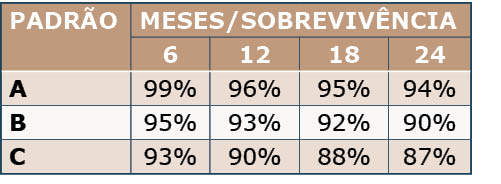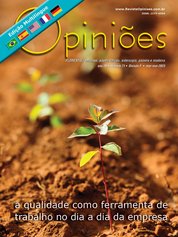Franco Freitas Quevedo
Coordenador de Pesquisa e Viveiro da CMPC
OpCP71
A influência da qualidade das mudas na produtividade florestal
A base florestal brasileira é reconhecida pelo seu progressivo desenvolvimento tecnológico e inovador, o que faz nossos hortos serem referência mundial em produtividade. Nesse contexto, há uma necessidade contínua dos avanços na qualidade das operações no setor para que a produtividade média das florestas se mantenha como padrão de referência. Esses fatores estão diretamente relacionados à produção de mudas de alta qualidade, uma vez que reduzem a heterogeneidade do plantio, impactando positivamente o manejo, a sobrevivência das próprias mudas em campo e o rendimento das florestas.
Para que uma floresta tenha um rendimento acima da média, é igualmente importante que a base do processo de produção seja bem conduzida, o que resultará na formação de mudas com parâmetros de qualidade adequados para o plantio. Para isso, todo o processo de propagação deve ser acompanhado e auditado, desde a adubação e a condução das cepas em minijardim clonal até a sua expedição. A sobrevivência, o estabelecimento e o arranque inicial do trato cultural são essenciais para o sucesso do plantio, e esses fatores estão diretamente ligados à qualidade das mudas expedidas do viveiro.
A qualidade das mudas precisa ser auditada, pois isso é fundamental para o bom desenvolvimento e a formação da floresta. A partir de análises e resultados experimentais, juntamente com a expertise dos viveiristas, alguns parâmetros para a seleção de uma muda de boa qualidade devem ser observados e considerados como critérios de avaliação. Os parâmetros mais avaliados devem ser:
• Altura: As mudas devem ter entre 20 cm e 40 cm. É necessária uma distância mínima entre as folhas e o solo para que, no inverno, se evite o congelamento da muda e, no verão, a queima do coleto.
• Idade: Para mudas com idade superior a 130 dias, deve-se restringir a expedição. Mudas “velhas” apresentam uma menor quantidade de raízes ativas, dificuldade de arranque inicial em campo e uma menor taxa de sobrevivência.
• Folhas: Três ou mais pares de folhas. Uma planta com menos de 3 pares de folhas expandidos não consegue realizar de forma completa e correta a sua fotossíntese, causando, assim, a diminuição ou o atraso de seu pleno desenvolvimento.
• Padrão de haste: Deve-se evitar mudas bifurcadas ou com inclinação superior a 45°.
• Toalete: Muitos galhos numa muda ou galhos que já estão muito lignificados devem ser limpos.
• Manchas foliares: Todas as manchas foliares causadas por doenças devem ser recuperadas antes do envio.
• Rustificação: Pontas vermelhas, caule avermelhado e resistência mecânica ao dobramento.
• Sanidade e nutrição: Ausência de sintomas de doenças e de desequilíbrio nutricional.
• Raiz: Sistema radicular com boa formação e bem distribuído, com raízes ativas e ausência de bolsões de ar.
Uma muda de alta qualidade torna-se uma floresta de alto padrão. Esses estudos, ao longo dos anos, vêm se repetindo, e os resultados sempre corroboram essa premissa. Buscando alcançar o potencial máximo de desenvolvimento dos hortos, a CMPC realiza um controle de avaliação de qualidade das mudas em quatro níveis:
1: EPS de produção de mudas
2: EPS de inspeção de qualidade
3: Analista de viveiro CMPC
4: EPS de Silvicultura
As avaliações de qualidade de mudas para o plantio são realizadas no ato da expedição. É selecionada uma amostragem de todas as caixas, analisando os principais parâmetros de qualidade. Após uma criteriosa análise, é gerado um certificado. Para serem classificadas, as mudas precisam atingir um indicador mínimo de 80 pontos. Caso contrário, não são expedidas. Ao longo dos últimos anos, diferentes experimentos em campo foram realizados para determinar e validar os critérios de avaliação da qualidade de mudas em viveiro.
Em um dos experimentos, as mudas foram segregadas em três grupos com diferentes padrões de qualidade, sendo os grupos:
A: selecionadas as mudas de melhor qualidade;
B: mudas de qualidade intermediária; e o grupo
C: mudas de menor qualidade. A avaliação dos parâmetros e sua influência na qualidade da floresta foram observados. Em análise, as mudas do padrão A resultaram em uma floresta mais produtiva e com elevada sobrevivência, como demonstra o quadro a seguir.
 Os resultados mostram os ganhos que se tem com uma expedição de alta qualidade, nos quais uma muda de padrão A, aos 24 meses, apresenta 7 pontos percentuais superiores em relação às mudas de padrão C. A qualidade das mudas associada ao manejo de implantação correto são os fatores de sucesso na produtividade florestal.
Os resultados mostram os ganhos que se tem com uma expedição de alta qualidade, nos quais uma muda de padrão A, aos 24 meses, apresenta 7 pontos percentuais superiores em relação às mudas de padrão C. A qualidade das mudas associada ao manejo de implantação correto são os fatores de sucesso na produtividade florestal.
 Os resultados mostram os ganhos que se tem com uma expedição de alta qualidade, nos quais uma muda de padrão A, aos 24 meses, apresenta 7 pontos percentuais superiores em relação às mudas de padrão C. A qualidade das mudas associada ao manejo de implantação correto são os fatores de sucesso na produtividade florestal.
Os resultados mostram os ganhos que se tem com uma expedição de alta qualidade, nos quais uma muda de padrão A, aos 24 meses, apresenta 7 pontos percentuais superiores em relação às mudas de padrão C. A qualidade das mudas associada ao manejo de implantação correto são os fatores de sucesso na produtividade florestal.
Atualmente, os controles de qualidade realizados são baseados em amostragem, pois são altos os volumes de mudas expedidas diariamente. Sendo assim, a busca por um sistema automático de avaliação de mudas que fundamentasse em dados já parametrizados otimizaria o processo de avaliação, resultando no aumento da quantidade de mudas analisadas e em uma avaliação mais realista de cada carga, tendo uma acurácia muito maior do que se tem hoje.
Um dos nossos propósitos na CMPC é a busca contínua por modernização, inovação e mecanização das atividades, sendo a análise
de qualidade de mudas expedidas um dos focos do trabalho. Estamos evoluindo junto com empresas de tecnologia no desenvolvimento desse equipamento para o avanço tecnológico na inspeção de mudas.
Controle de qualidade de mudas deve ser tratado com investimento, tendo em vista que mensurar a qualidade de todas as operações, incluindo mudas, gera ganhos, aumenta a produtividade e produz florestas melhores.





